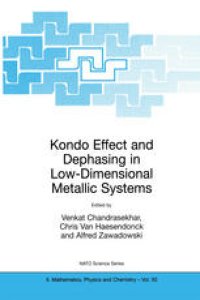
Ebook: Kondo Effect and Dephasing in Low-Dimensional Metallic Systems
Author: T. M. Jacobs N. Giordano (auth.) Venkat Chandrasekhar Chris Van Haesendonck Alfred Zawadowski (eds.)
- Tags: Condensed Matter Physics, Magnetism Magnetic Materials, Metallic Materials, Optical and Electronic Materials
- Series: NATO Science Series 50
- Year: 2001
- Publisher: Springer Netherlands
- Edition: 1
- Language: English
- pdf
The NATO Advanced Research Workshop took place from 29 May to I June 2000 in the picturesque Hungarian town of Pecs, 220 km south of Budapest. The main goal of the workshop was to review and promote experimental and theoretical research on the problem of Kondo-type scatteringofthe electrons in systems ofreduced dimensionalities. 53 regular participants and 7 observers from 17 different countries attended the workshop. The Kondo effect has been a topic ofintense interest for many years, due in part to its relevance to a variety of other branches of condensed matter physics. In addition to the best known example of magnetic impurities in noble metals, the physics of the Kondo effect is important in many areas of current research, including heavy-fermion physics, correlated electron systems, and high-temperature superconductivity. Of central importance in this problem is the interaction of conduction electrons in the metal with individual magnetic impurities, an interaction which also mediates the interaction ofthe impurities with each other.
The availability of nanolithographic tools and new spectroscopies (scanning tunneling microscope, mechanically controllable break junctions) has opened the possibility of directly probing the Kondo effect on the relevant mesoscopic size scale. This book brings together the major progress that has been made during the past few years on low-dimensional Kondo systems. Apart from size effects in dilute magnetic alloys, the book focuses on the two-channel Kondo effect to describe two-level systems which influence the electron transport through metallic nanobridges and cause dephasing in disordered metal films. It also reveals how quantum dots can be used as perfectly tunable Kondo systems.
The availability of nanolithographic tools and new spectroscopies (scanning tunneling microscope, mechanically controllable break junctions) has opened the possibility of directly probing the Kondo effect on the relevant mesoscopic size scale. This book brings together the major progress that has been made during the past few years on low-dimensional Kondo systems. Apart from size effects in dilute magnetic alloys, the book focuses on the two-channel Kondo effect to describe two-level systems which influence the electron transport through metallic nanobridges and cause dephasing in disordered metal films. It also reveals how quantum dots can be used as perfectly tunable Kondo systems.
Content:
Front Matter....Pages i-xxii
Effect of Disorder on the Kondo Behavior of Thin Cu(Mn) Films....Pages 1-10
The Kondo Effect and Weak Localization....Pages 11-22
Surface Magnetic Anisotropy of Kondo Impurities Induced by Spin-Orbit Scattering....Pages 23-32
Thermopower of Mesoscopic Spin Glasses....Pages 33-42
Shape-Induced Magnetic Anisotropy in Dilute Magnetic Alloys....Pages 43-52
Zero-Bias Transport Anomaly in Metallic Nanobridges....Pages 53-62
Conductance Noise and Irreversibility in Diluted Magnetic Semiconductors....Pages 63-72
Enhancement of Kondo Temperature in Nanometer-Size Point Contacts....Pages 73-85
Scanning Tunnelling Spectroscopy of A Single Kondo Impurity....Pages 87-95
Two-Channel Kondo Effect from Tunneling Impurities....Pages 97-106
Electron Decoherence at Zero Temperature....Pages 107-117
Probing Interactions in Mesoscopic Gold Wires....Pages 119-132
Kondo Effect in Non-Equilibrium....Pages 133-142
Tunneling Through A Quantum Dot....Pages 143-152
Electron Transport Through Quantum Dots: An Unusual Kondo Effect....Pages 153-161
The Kondo Effect in a Single-Electron Transistor....Pages 163-170
Flux Dependent Dielectric Response of Stacked Nanoscopic Rings....Pages 171-174
Giant Magnetoresistance of a Single Interface....Pages 175-180
Fermi Edge Singularities in Transport Through Quantum Dots....Pages 181-184
Theory Of Magnetoresistance in Films of Dilute Magnetic Alloys....Pages 185-188
Current and Shot Noise in a Ferromagnetic Double Tunnel Junction with an Atomic Size Spacer....Pages 189-192
Positive Domain-Wall Magnetoresistance of Ferromagnetic Point Contacts....Pages 193-196
Enhancement of Kondo Effect Due to Spin-Singlet-Triplet Competition in Quantum Dots....Pages 197-201
A Non-Kondo Interpretation of the Experimentally Observed “Kondo Resonances” in Quantum Dots....Pages 203-206
Diagrammatic Theory of the Anderson Impurity Model with Finite Coulomb Interaction....Pages 207-210
Generalized Conductance Sum Rule in Atomic Break Junctions....Pages 211-214
Is CeNiSn a Kondo Semiconductor?....Pages 215-218
The Influence of Single Magnetic Impurities on the Conductance of Quantum Microconstrictions....Pages 219-222
Structural Properties of Colloidal Co Nanoparticles....Pages 223-226
Interacting Electrons in a Nearly Straight Quantum Wire....Pages 227-229
Resonant Tunneling Through an Impurity Level: A Probe of Coherent States in a Disordered Metal....Pages 231-235
Pair Breaking in s-Wave Superconductors by Two-Channel Kondo Impurities....Pages 237-240
Theory of Scanning Tunneling Spectroscopy of Kondo Ions on Metal Surfaces....Pages 241-244
Two-Level Systems in Atomic-Size Point Contacts....Pages 245-248
Is The Multi-Channel Kondo Model Appropriate to Describe Single Electron Transistors?....Pages 249-252
Back Matter....Pages 253-256
....Pages 257-265